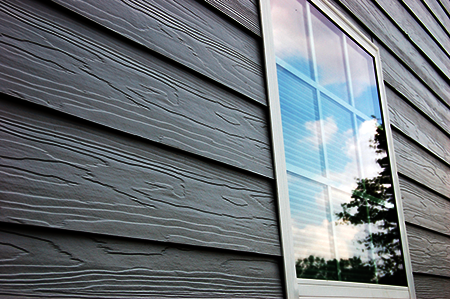Fiber Cement Siding
Building a new house, addition, workshop, garage, or barn, or if it’s time to change the old, ‘weather beaten’ siding on your house, we recommend fiber cement siding. What is fiber cement siding? Fiber cement siding is applied to the exterior of buildings like any other siding, to protect the house from the elements. This product comes in a wide variety of styles and colors that are similar to conventional siding, like stucco, wood clapboards and cedar shingles. It is primarily made from cement, wood fiber and sand. This combination resulted in an exceptionally durable material.
Fiber cement siding usually costs more than vinyl siding but less than stucco. It also lasts longer than its competitors- often by decades, due to its resistance to many common threats, including rain, wind, insects and fire. Fiber cement siding is suggested in all climates, but is best for hot and humid regions. No matter how damp it gets, it will not rot. And it is termite-proof because of the sand and cement content. Because of its stability, fiber cement siding cuts maintenance costs, and is least expected to end up in dump yards than conservative siding. Though many homeowners and builders are just noticing its benefits, this material has been around for nearly 100 years. So you aren’t experimenting with new product.

Fiber cement siding made with smooth finish or wood grained are popular. These come in widths of four to twelve inches, so you can match with your existing siding if you are building a garage or an addition. For the underneath of overhangs, soffit panels and Wall panels with vertical grooves are also available.
Fiber cement siding may be primed and painted at the factory or on the construction site. Factory primed and painted siding are recommend as they often carry a warranty of up to twenty-five years. Manufacturers usually recommend an alkaline-resistant-primer and a 100% acrylic top coat for those who like to do the priming and painting themselves. If you feel like changing the color after a few years, no problem. Water-based acrylic paints stick well. And fiber cement siding doesn’t expand or contract as much as wood siding, so paint stays in place. It hardly blisters or peels, reducing maintenance cost and time.
Installing new siding is comparatively simple as long as you have basic construction skills and tools. But it is best left to pros as it weighs around 2½ pounds per square foot and it tends to crash if mishandled. A decent house-wrap underneath siding is an important element in green building since it “breathes,” letting moisture vapor to escape. This prevents rot, which may cause health problems and damage to your home.
Fiber cement siding is more costly than vinyl, but similar to wood in price. The cost is determined by numerous factors, such as type of siding, the style of paint, whether the siding is ‘pre finished’ or painted on-site and the size of your house.
